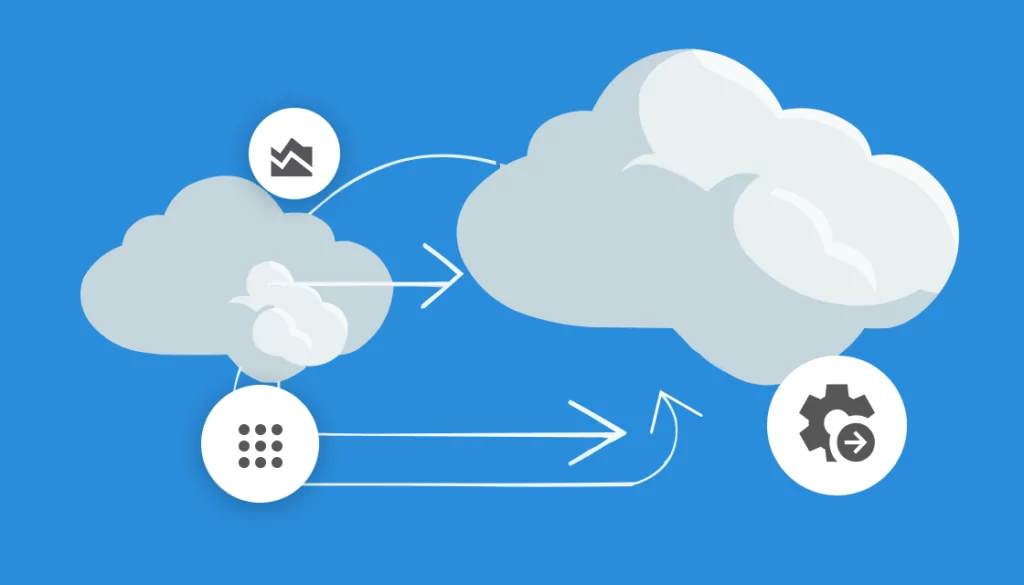The explosion of the cloud has changed the face of how enterprises do business, and it’s not slowing down any time soon.
In fact, Cisco believes that cloud data centers now process as much as 94% of all workloads. Let’s take a look at some of the most important trends and how you can stay on top of the cloud management platform market to make your hybrid cloud strategies more successful. (For more information, see our Guide to Cloud Migration.)
Table of Contents
Toggle- Trend 1: Multi and Hybrid Cloud Environments Will Continue to Grow
- Trend 2: Retaining Compliance in an Increasingly Complex Environment
- Trend 3: Organizations will make Cloud Savings a Priority
- Trend 4: Solution-focused Partners
- Trend 5: A Continued Shift to Tech on Demand
- What’s Next? The Next Level of Cloud Computing Trends...
- Stay Ahead with Faddom
Trend 1: Multi and Hybrid Cloud Environments Will Continue to Grow
Businesses recognize that cloud data management isn’t about having one specific cloud platform or infrastructure, it’s about choosing the solution that’s right for the job at hand. In some cases, this isn’t cloud at all, it might be on-premises or even legacy systems, especially where enterprises are locked into specific systems for business-critical solutions that are cumbersome or complex to adapt.
In 2021, the emerging cloud trend is that enterprises are becoming less worried about sticking with one vendor, and are embracing a multi cloud or hybrid cloud offering where they can get the best out of each solution. According to Global Channel Chief at Google, Carolee Gearhart, “Gartner is estimating that by 2021, 75 percent of midsize and large organizations will have adopted multi-cloud or a hybrid strategy.” IDC affirms this in their 2021 report, stating that by 2022, over 90% of enterprises will be relying on a hybrid cloud solutions model that includes on-prem, dedicated private clouds, multiple public clouds AND legacy platforms.
Trend 2: Retaining Compliance in an Increasingly Complex Environment
In order to join this trend, businesses need to have a vendor-agnostic approach and look for SaaS solutions that reduce bottlenecks or blind spots. Visibility across a heterogeneous environment will be more important than ever, ensuring that organizations can achieve the same level of insight across the board, in various instances and platforms, without gaps.
Learn more in our detailed guide to cloud implementation
If this is unsuccessful, these blind spots could be leveraged by cyber-attackers, or could leave issues for internal governance and compliance. At the moment, data privacy and security are cited as the top roadblocks for enterprise cloud adoption, and introducing additional infrastructure into the mix further complicates the matter.
Trend 3: Organizations will make Cloud Savings a Priority
According to Gartner, the worldwide revenue from public cloud will grow by 17% this year to $266.4 billion. A record-breaking 60% of organizations will be using an external cloud provider’s managed services offering by 2022, doubled from 30% in 2018 – growth is an undeniable trend in the cloud computing market.
The decentralized model of consumption has raised costs for organizations exponentially, and often without any control over the spiraling bottom line. Businesses will have to start to control these cloud costs as usage grows, streamlining the expenditure that they are not utilizing to full effect, and cutting out duplicate spending or unnecessary overheads.
As different cloud and hybrid services have different pricing and billing models, and costs can change from month to month, this could be a tall order. Innovative third-party solutions that can support organizations in getting granular insight into their hybrid network and provide unified management of costs will rise to the top.
Trend 4: Solution-focused Partners
As businesses continue to move their infrastructure using SaaS, PaaS and IaaS, one cloud trend is that there will be a continued need for third-party vendors who really specialize in meeting specific use cases and problem-solving new cloud challenges. While your cloud provider will be responsible for cloud infrastructure needs such as storage, outsources will be taking care of compute and networking, specific needs such as data, visibility, AI and ML technology, or IoT.
These external partners will need to have a strong insight into how cloud computing and its associated technologies work, leaving the hardware element to AWS or the other infrastructure leaders, but well-versed in how to get the best solutions on both the cloud and on-premises for specific organizational needs.
Trend 5: A Continued Shift to Tech on Demand
As costs get taken under control, businesses will have more revenue at their disposal to take advantage of these solutions that beat their specific industry challenges. In turn, providers will look to push out innovation that is easily accessible to a wide audience, has a low learning curve, low-code interface, and is more democratized overall, so that anyone can reap the rewards. Without the need for a team of data scientists, organizations will begin to see the benefits of Machine Learning, AI, and automation in a very tangible way to solve and enhance business strategy and an exciting cloud computing trend in 2021. This is only reiterated by the offerings that cloud providers are pushing to the masses, such as Azure’s Machine Learning Experimental UI, the focus on AI and ML at AWS Innovate, and GCP’s Auto ML.
What’s Next? The Next Level of Cloud Computing Trends…
The cloud has started to reach its full potential, as a conduit for organizations of all sizes to realize huge amounts of value. The first step is already here, as businesses can now utilize infrastructure that has resources that they could never have achieved on their own.
The next level of trends that we’re going to see as we move through 2022 and into 2023 is organizations getting ahead of the challenges of compliance and security, and partnering with smart, innovative external solutions. These companies will already have a deep understanding of the new hybrid reality, and therefore allow forward-thinking customers to see an immediate benefit from their targeted skills and expertise.
Stay Ahead with Faddom
The cloud landscape is evolving rapidly, and staying on top of trends like hybrid cloud adoption, cost optimization, and compliance is critical for success. Faddom empowers your organization with fast deployment and real-time application dependency mapping, giving you unmatched visibility and actionable insights.
Take control of your cloud strategy and start optimizing today—schedule a call with our experts and explore a free trial license!







